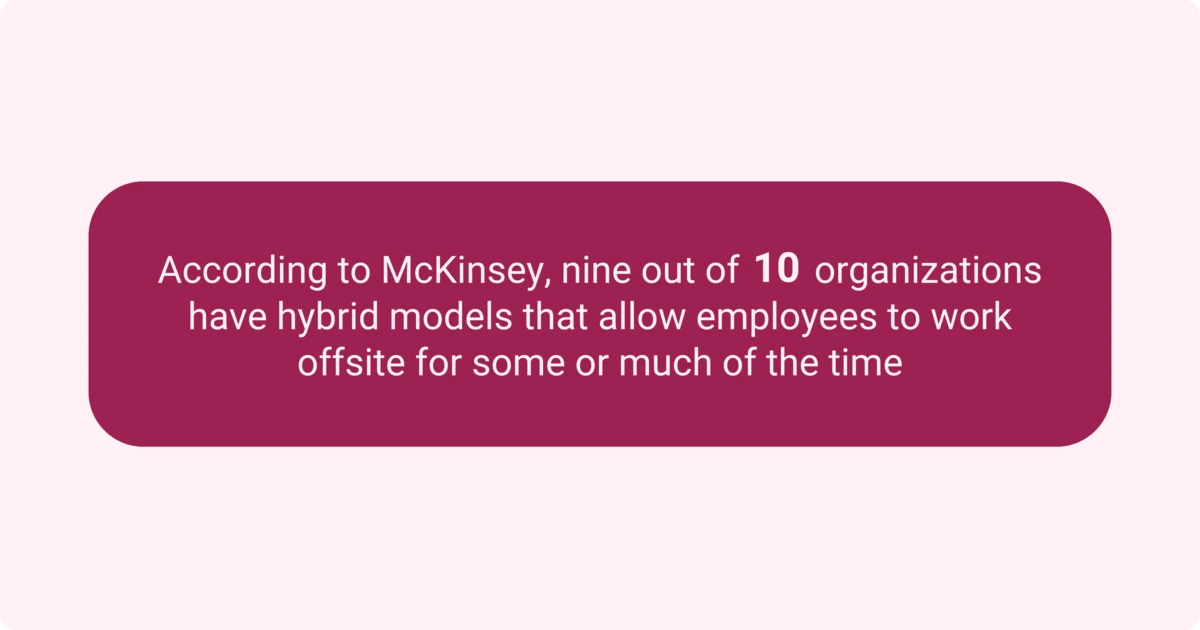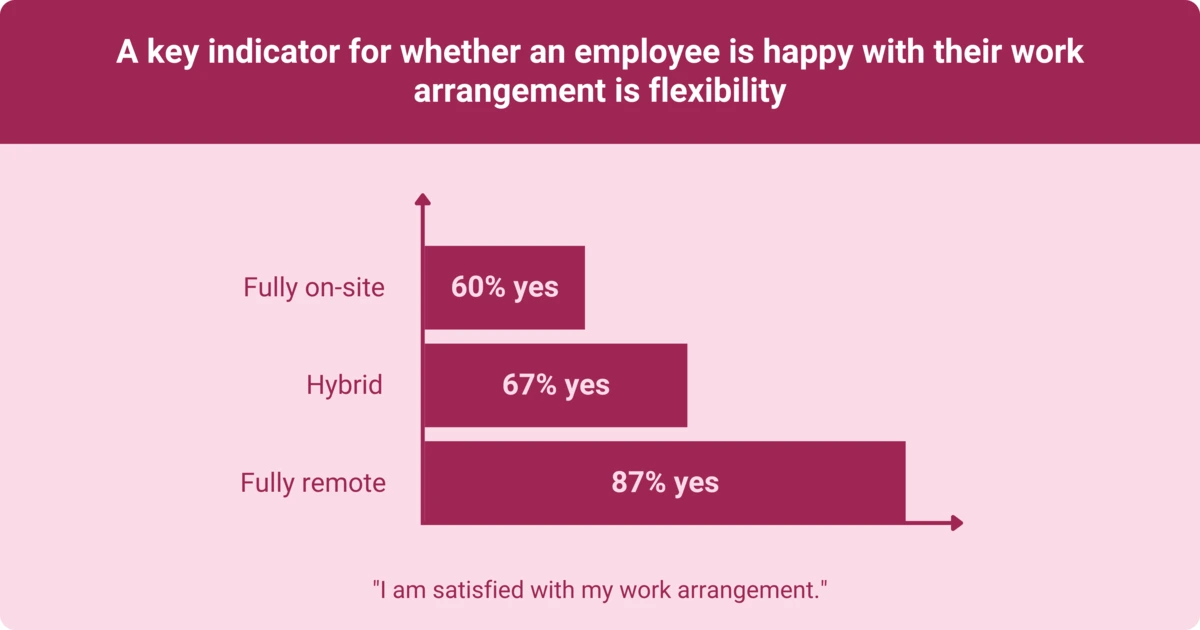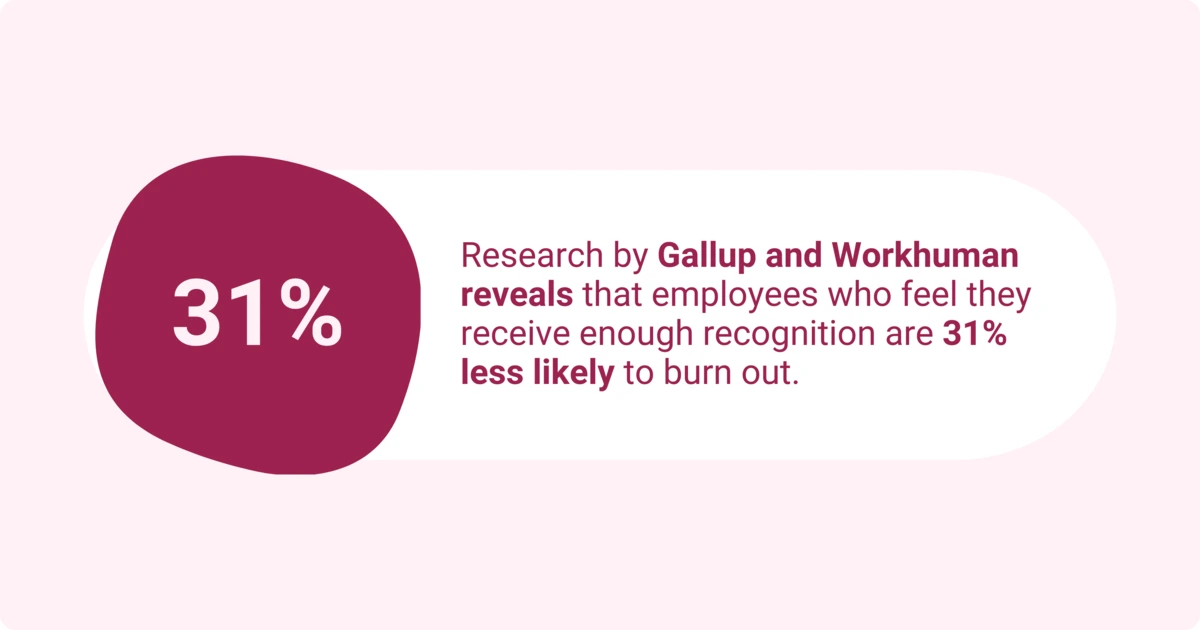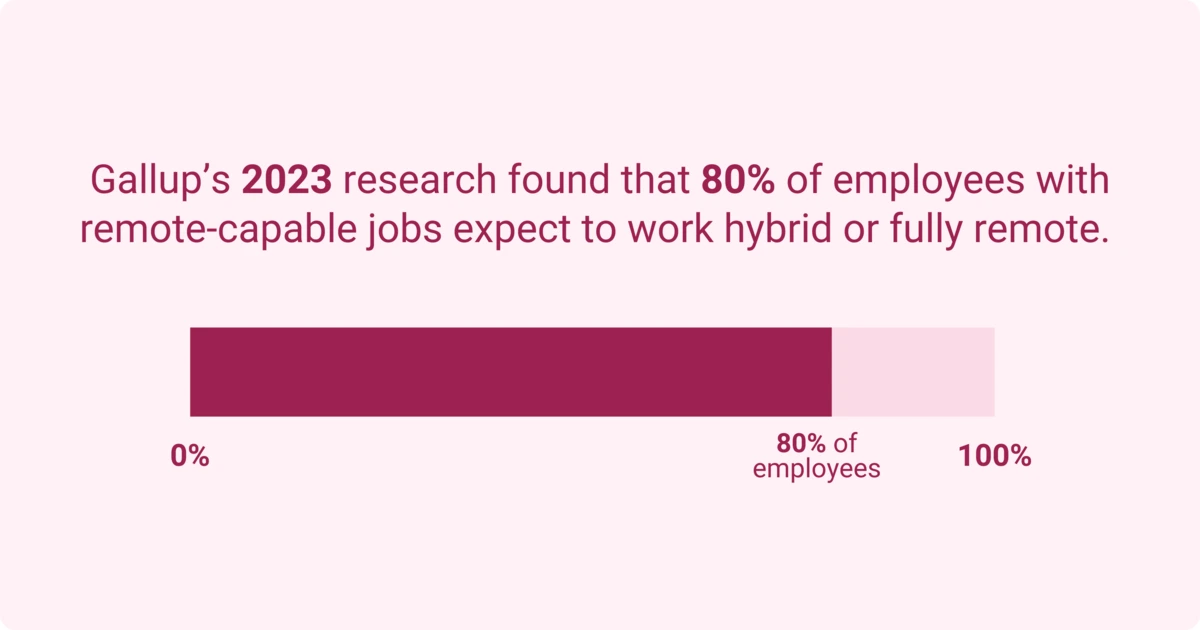Managing a Hybrid Team: Strategies, Tools, and Best Practices

Remote work spiked during the COVID-19 pandemic, as confirmed by the Bureau of Labor Statistics' report, The rise in remote work since the pandemic and its impact on productivityOpens in a new tab. Lockdowns, office closures, and social distancing forced employees to work from home.
Years later, remote work for many has given way to hybrid work – in-person office days for teams to collaborate while still offering employees the freedom to work remotely part of the week. And with it came the questions about managing a hybrid team.
In Zoom’s “Navigating the Future of Work: Global Perspectives on Hybrid Models and Technology” report, 64% of employees said their organization has a hybrid model. Hybrid work provides employees with flexibility. However, it also comes with coordination, team engagement, and communication issues. How do you overcome these challenges?
Below, you’ll learn strategies, tools, and best practices for managing a hybrid team effectively.
What is hybrid team management?
Hybrid team management refers to the practice of leading and coordinating a workforce that includes both in-office and remote employees.
This management style balances the needs of both groups, ensuring productivity, collaboration, and engagement while navigating challenges like communication barriers, time zone differences, and maintaining company culture.
Importance of effective management for a successful hybrid workplace
According to McKinsey, nine out of 10 organizations have hybrid models that allow employees to work offsite for some or much of the time. This offers employees a flexible work arrangement.
But if companies aren’t careful, it could disrupt the human connection, sense of belonging, and engagement that workplace leaders have worked so hard to build over the years.
Effective hybrid team management prevents that from happening by:
- Enhancing collaboration in a hybrid work environment
- Ensuring fairness
- Driving productivity
- Improving employee satisfaction

7 key strategies for managing a hybrid team
Hybrid work is like a finely tuned recipe — too much office time, and employees lose flexibility; too much remote work, and collaboration suffers. Finding the right balance is the key to success.
The combination has to be just right. This poses a challenge to managers who must balance employee preferences with the organization's productivity goalsOpens in a new tab and team collaboration needs.
The good news is that you can lead and coordinate your workforce effectively if you use proven strategies for managing hybrid teams.
1. Set goals and define responsibilities
What is your team striving to achieve? Without clear goals, hybrid work can become a confusing free-for-all. Define objectives using the SMART framework — specific, measurable, achievable, relevant, and time-bound. This ensures alignment and eliminates ambiguity.
Once the goals are set, assign roles and responsibilities to the entire team. Each team member should know what exactly is expected of them, including tasks, deliverables, and deadlines. This clarity prevents miscommunication and keeps everyone accountable, regardless of where they work.
2. Provide flexible work setups
One of the biggest advantages of hybrid work is flexibility, so embrace it. Give employees the ability to choose when and where they work within defined guidelines. For example, instead of rigid schedules, set a maximum number of remote workdays per month and let employees decide which days they’ll be in the office.
However, avoid micromanaging remote work hours. Instead of tracking when employees clock in and out, focus on outcomes. Was the project completed on time? Does it meet expectations? Results should be the primary measure of success.
Flexibility is no longer just a perk — it’s a priority. A Workhuman study found that nearly one-quarter of employees would take a pay cut in exchange for their preferred work arrangement. Providing this autonomy boosts morale and retention.

3. Conduct regular check-ins for each remote employee
When done right, one-on-one check-ins ensure managers stay connected with hybrid team members, address challenges early, and support professional growth. But not all check-ins are created equal. Here’s how to make them more effective and improve your employee management skills:
✅ Start with small talk. Build rapport by asking about non-work topics like hobbies or family before diving into business.
✅ Be fully present. Avoid distractions like checking emails or Slack messages—engaged listening strengthens trust.
✅ Focus on solutions. If someone is struggling, shift from blame to problem-solving: “What barriers are you facing, and how can I help?”
Why does this matter? In our “The Future of Work is Human” report, research found that employees who check in with their manager at least once per week (compared to those who never do) are:
- 2x more likely to trust and respect their manager
- 5x less likely to be disengaged
- 2x more likely to see career growth opportunities
In a hybrid setup, check-ins aren’t just helpful — they’re essential.
4. Promote effective communication
In hybrid teams, communication gaps can create two separate work experiences: in-office employees who have quick access to information and remote workers who feel out of the loop.
To bridge this gap, ensure that everyone gets the same information at the same time, no matter where they work. Tools like Slack, Microsoft Teams, and Notion make updates instantly accessible, preventing any one group from having an advantage over the other.
But don’t just rely on messaging apps. Schedule regular team meetings where both in-office and virtual teams can contribute equally. Create shared digital spaces for brainstorming and decision-making to reinforce team cohesion.
5. Build an inclusive and equitable team environment
An inclusive team isn’t just diverse, it’s one where every employee, regardless of location, has an equal shot at success. Without intentional efforts, remote employees can be at a disadvantage when it comes to visibility, opportunities, and career growth.
To create an equitable hybrid workplace:
✅ Ensure equal access to tools & training – Remote employees should have the same communication platforms, productivity software, and learning opportunities as their in-office counterparts.
✅ Standardize development opportunities – Offer mentorship programs, leadership training, and promotions based on skills and performance — not just proximity to leadership.
✅ Customize flexibility & support – Recognize that employees have different working styles and personal needs. Where possible, offer personalized flexibility in schedules, workload management, and the level of support they receive.
✅ Make participation inclusive – Ensure remote employees are included in key discussions by offering virtual participation options, recording important meetings, and actively inviting input from everyone.
An inclusive hybrid team isn’t just about fairness, it drives higher employee engagement, innovation, and retention. When employees feel valued and empowered, they don’t just show up — they thrive. 🚀
6. Monitor employee well-being and proactively address burnout
Employee burnout leads to poor well-being. And according to Gallup, it can lower productivity, reduce employee retention, and increase absenteeism. Signs and symptoms of burnout include:
- Exhaustion
- Disengagement (People feeling mentally distant from their job or having a negative attitude towards their profession)
- Lower productivity or decreased quality of work
One way to address this problem is through recognition. Research by Gallup and Workhuman reveals that employees who feel they receive enough recognition are 31% less likely to burn out. Employee recognition solutions like Social Recognition can help you acknowledge hardworking individuals.

Other ways to fight burnout include:
- Assign manageable workloads to employees.
- Clearly communicate expectations and provide all the support hybrid workers need to do their jobs effectively.
- Set reasonable deadlines.
Addressing burnout or anything that affects employees' well-being allows you to combine mindfulness and leadership. This can be a great way to cultivate a company culture where employees feel secure and cared for.
7. Build a strong team culture
Hybrid work gives employees the flexibility they love—but it can also lead to feelings of isolation. In Leeman’s international study of 2,400 employees on connection and collaboration in hybrid workOpens in a new tab, 91% said they like hybrid work, yet nearly 50% admitted they sometimes or frequently feel socially disconnected from their colleagues.
Without the natural camaraderie of a shared office, leaders must be intentional about building connection and belonging with a hybrid workforce. Here’s how:
Create shared experiences
Hybrid teams need moments of connection — both virtual and in person — to foster a sense of togetherness.
- Organize hybrid-friendly activities like virtual career development workshops that include both remote and in-office employees.
- Plan quarterly team meetups—whether it’s an offsite retreat, a team lunch, or an in-person strategy session.
These experiences strengthen relationships and prevent the “two-tier” divide between remote and office workers.
Foster a shared identity
A strong team culture isn’t just about collaboration, it’s about belonging. Employees should feel like they’re part of something bigger than just their day-to-day tasks.
- Celebrate team wins with recognition and rewards to create a sense of pride and identity.
- Create team traditions, like monthly virtual hangouts, meme-sharing channels, or Friday wins recaps.
When employees feel connected to their team’s mission and identity, engagement naturally follows.
Encourage storytelling and human connection
People connect through stories, not just meetings. Give employees opportunities to share their journeys and learn about their teammates on a personal level.
- Host storytelling sessions where employees talk about why they joined the company or how they got into their profession.
- Run "Day in the Life" takeovers, where employees showcase their work routines on Slack or internal blogs.
These small but meaningful actions bring humanity into hybrid work, making interactions less transactional and more personal.
Technology and security considerations for hybrid teams
Technology is the backbone of a successful hybrid workplace. The right tools enhance communication, streamline workflows, and keep sensitive data secure. But not every platform is built for hybrid teams. Selecting scalable, secure, and user-friendly solutions is critical to ensuring seamless collaboration and protecting company information.
1. Choose the right productivity and communication tools
A hybrid team needs more than just email and video calls. Look for platforms with real-time collaboration, task tracking, and file-sharing capabilities to keep everyone aligned.
Here is your essential tech stack for hybrid teams:
✅ Communication: Microsoft Teams, Slack, Zoom
✅ Project and task management: Asana, Trello, ClickUp
✅ Document sharing and collaboration: Google Workspace, Notion, SharePoint
✅ Employee performance and engagement: Workhuman Conversations (for continuous feedback), Workhuman Social Recognition (for employee recognition)
By standardizing these tools across your organization, you prevent information silos and ensure all employees, whether in-office or remote, stay on the same page.
2. Strengthen security for remote work
A hybrid work model expands cybersecurity risks, as employees access company resources from various locations and devices. To mitigate threats, implement strong security measures that protect sensitive data without disrupting workflow.
🔐 Key security protocols for hybrid teams:
✔ Use Virtual Private Networks (VPNs): A VPN encrypts internet connections, ensuring that remote employees securely access company systems as if they were in the office.
✔ Implement Multi-Factor Authentication (MFA): Adding an extra layer of verification prevents unauthorized access to business applications.
✔ Enable end-to-end encryption for virtual meetings and messages: Platforms like Microsoft Teams and Zoom offer encryption to protect confidential discussions from cyber threats.
✔ Regularly update security software: Ensure firewalls, antivirus programs, and software patches are up to date to defend against vulnerabilities.
3. Train employees on cybersecurity best practices
According to Harvard research, human error is the leading cause of cyber incidents. Without proper training, employees may unknowingly expose sensitive data through phishing attacks, weak passwords, or unsecured devices.
Cybersecurity training essentials:
🔹 Teach employees how to recognize phishing emails and social engineering attacks.
🔹 Require strong password policies and encourage employees to use password managers.
🔹 Educate employees on secure remote work practices, such as avoiding public Wi-Fi for work-related tasks.
🔹 Conduct regular security drills and assessments to test employee awareness.
When employees understand how to protect company data, they become the first line of defense against cyber threats.
4. Ensure technology supports performance and engagement
A hybrid team’s success isn’t just about staying connected—it’s about staying engaged. Beyond communication tools, managers need platforms that help employees receive feedback, track growth, and feel valued.
🔹 For continuous performance management: Workhuman Conversations allows employees to request and receive real-time constructive feedback, helping managers track progress and support development.
🔹 For employee recognition: Workhuman’s Social Recognition software enables managers to highlight top performers, ensuring that both in-office and remote employees feel seen and valued.
When technology supports both productivity and well-being, hybrid teams become more engaged, collaborative, and high-performing.
Future of hybrid team management
According to Zoom’s report on hybrid models in the workplace, 84% of leaders say that generative AI has increased productivity. Many plan to integrate the technology further into their work setups in the near future. That means AI tools will become a big part of hybrid team management.
In addition, the expectations of the modern workforce are shifting. Gallup’s research on the future of in-office workOpens in a new tab found that 80% of employees with remote-capable jobs expect to work hybrid or fully remote.

The study also reinforced that hybrid models are now the most common work arrangement in offices. This trend will make hybrid team management more popular in the future as most remote-capable employees will be working from locations they prefer.
Organizations that don’t offer hybrid work yet should master the best practices of hybrid team management to prepare for the future. They should also start planning on implementing remote work tools.
Conclusion
Hybrid work is no longer an experiment, it’s the new standard. As organizations continue refining their hybrid models, the key to success when it comes to managing a hybrid team lies in intentional management strategies, inclusive culture-building, and the right technology.
By setting clear expectations, fostering a sense of belonging, and prioritizing security, leaders can create an environment where both in-office and remote team members thrive.
As the workplace evolves, AI-driven tools, flexible policies, and employee engagement initiatives will shape the next generation of hybrid teams. Companies that embrace these changes will stay competitive, attract top talent, and build resilient, high-performing teams for the future.